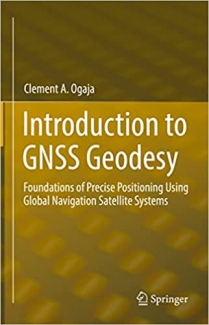جلد سخت سیاه و سفید
Product details
- Publisher : Springer; 1st ed. 2022 edition (May 26, 2022)
- Language : English
- Hardcover : 181 pages
- ISBN-10 : 3030918203
- ISBN-13 : 978-3030918200
کتاب Introduction to GNSS Geodesy: Foundations of Precise Positioning Using Global Navigation Satellite Systems
Introduction to GNSS Geodesy is a concise reference for beginners and experts in GNSS-based satellite geodesy. It covers all of the important concepts in almost a third of the space of the other GNSS books. Th e book begins with a case study in Augmented Reality to set the stage for what is to come and then moves on to the key elements of GNSS geodesy that make accurate and precise geopositioning possible. For example, it is important to understand the geodetic reference systems and the associated GNSS data processing strategies that enable both accurate and high-precision geopositioning. Chapter 2 gives an overview of GNSS constellations and signals, highlighting important characteristics. Chapter 3 then introduces reference systems in geodesy, covering such topics as time systems, geodetic datums, coordinate systems, coordinate conversions and transformations, and International Terrestrial Reference Frame. Th is lays the framework for the rest of the book.
Chapters 4 and 5 dig deep into mathematical formulation of GNSS parameter estimation and observation models. All the concepts are presented clearly and concisely, with diagrams to assist reader comprehension. Chapter 6 describes Continuously Operating Reference Station (CORS) networks and their role in geodesy and definition of reference frames. Various global and regional CORS networks are presented in this section. Th e chapter also covers GNSS data and common formats such as RINEX and RTCM. Chapter 7 introduces the whole cycle of GNSS data processing, including preprocessing, ambiguity fixing, and solution reprocessing methods as commonly used in both epoch solutions and time series data. Th e book concludes with appendices on orbit modelling, GNSS linear combinations, application examples, and an example linear model.
منابع کتاب کتاب Introduction to GNSS Geodesy: Foundations of Precise Positioning Using Global Navigation Satellite Systems
مقدمه ای بر GNSS Geodesy یک مرجع مختصر برای مبتدیان و متخصصان ژئودزی ماهواره ای مبتنی بر GNSS است. این کتاب تمام مفاهیم مهم را در تقریبا یک سوم فضای سایر کتاب های GNSS پوشش می دهد. این کتاب با یک مطالعه موردی در واقعیت افزوده شروع میشود تا زمینه را برای آنچه در آینده فراهم میکند و سپس به عناصر کلیدی ژئودزی GNSS میپردازد که موقعیتیابی دقیق و دقیق جغرافیایی را ممکن میسازد. به عنوان مثال، درک سیستمهای مرجع ژئودزیکی و استراتژیهای پردازش دادههای GNSS مرتبط که امکان موقعیتیابی دقیق و با دقت بالا را فراهم میکنند، مهم است. فصل 2 یک نمای کلی از صورت های فلکی و سیگنال های GNSS ارائه می دهد و ویژگی های مهم را برجسته می کند. فصل 3 سپس سیستم های مرجع در ژئودزی را معرفی می کند و موضوعاتی مانند سیستم های زمانی، داده های زمین شناسی، سیستم های مختصات را پوشش می دهد. هماهنگی تبدیل ها و تبدیل ها، و چارچوب مرجع بین المللی زمینی. Th is چارچوبی را برای بقیه کتاب ایجاد می کند.
فصلهای 4 و 5 به فرمول ریاضی مدلهای برآورد و مشاهده پارامتر GNSS میپردازند. تمام مفاهیم به طور واضح و مختصر با نمودارهایی برای کمک به درک خواننده ارائه شده است. فصل 6 شبکه های ایستگاه مرجع دائمی (CORS) و نقش آنها در ژئودزی و تعریف چارچوب های مرجع را تشریح می کند. شبکه های مختلف جهانی و منطقه ای CORS در این بخش ارائه شده است. این فصل همچنین داده های GNSS و فرمت های رایج مانند RINEX و RTCM را پوشش می دهد. فصل 7 کل چرخه پردازش داده های GNSS را معرفی می کند، از جمله روش های پیش پردازش، رفع ابهام و روش های پردازش مجدد راه حل که معمولاً در راه حل های دوره ای و داده های سری زمانی استفاده می شود. این کتاب با ضمیمههایی در مورد مدلسازی مدار، ترکیبهای خطی GNSS، مثالهای کاربردی و نمونهای از مدل خطی به پایان میرسد.































ارسال نظر درباره کتاب Introduction to GNSS Geodesy: Foundations of Precise Positioning Using Global Navigation Satellite Systems